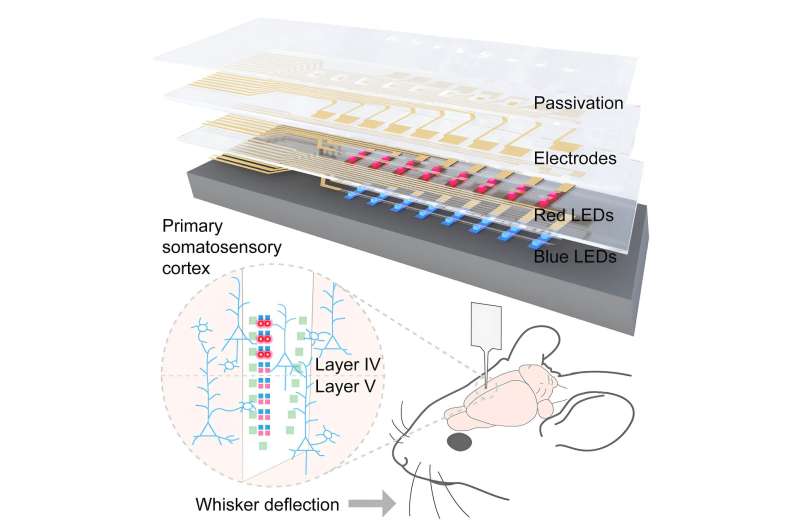This article has been reviewed according to Science X's editorial process and policies. Editors have highlighted the following attributes while ensuring the content's credibility:
fact-checked
peer-reviewed publication
trusted source
proofread
Researchers develop first high-precision dual-color optoelectronic brain probe

A team of researchers at the University of Massachusetts Amherst has developed the first dual-color optoelectronic neural probe.
Unlike previous, single probes, which often control brain activity in only one direction—excitation or inhibition, but not both—this new design can enhance and silence the electrical activities of the same neurons within specific cortical layers of the brain. It promises aid the investigation of tightly packed neural microcircuits within the cortex and deep brain regions and, in the longer term, add to the functional mapping of the brain.
Guangyu Xu, assistant associate professor of electrical and computer engineering, an appointee of the Dev and Linda Gupta Professorship at UMass Amherst, and principal investigator of the study hopes the device can ultimately help researchers identify the origin of brain diseases.
The device is based on optogenetics, a method to control neural activity using light, explains Xu. "We are able to send one of two colors of light (red or blue) to the brain to let neurons within each cortical layer become more active or more silent, as you can tell from electrical neural recording signals," he says. "This capability, namely bidirectional optogenetic electrophysiology, will lend itself to high-resolution interrogation of the brain circuitry and shed light on animal disease models."
He says that bidirectional control is crucial for advancing the understanding of diseases such as epilepsy and Parkinson's disease. "For instance, with epilepsy, you may need to silence certain regions of the brain, not to activate them," he says. "That requirement is one of our motivations in building such dual-color devices. The second color on the probe adds flexibility in optical control over the brain."
Building such devices is not trivial, requiring different optoelectronic materials to be packed into a small footprint—less than a millimeter in size—with low crosstalk to each other. "We developed a high-yield integration approach in this work," says Xu.
Published in Cell Reports Physical Science, this work marks the first preliminary test of this technology, showcasing the device's power to provide a high spatial resolution and bidirectional control of the brain in mice. "What we did on mice is turn on those blue or red LEDs to shut off or turn on the same local brain circuits," he says. "And this spatial resolution comes down to specific cortical layers, as suggested in the recording traces."
He anticipates that future research will extend to testing the device on other body parts, possibly outside the brain.
More information: Dacheng Mao et al, Close-packed dual-color micro-LEDs enable cortical-layer-specific bidirectional in vivo optogenetic electrophysiology, Cell Reports Physical Science (2023). DOI: 10.1016/j.xcrp.2023.101702


















